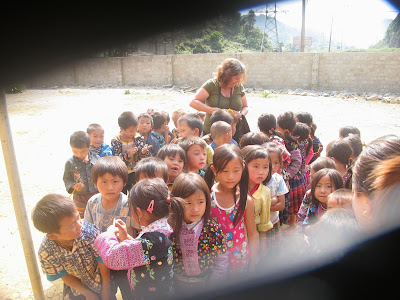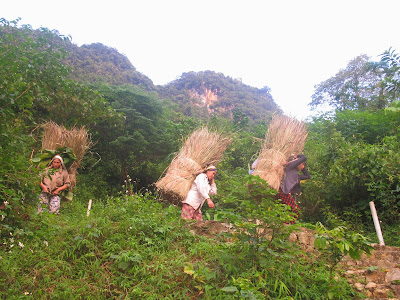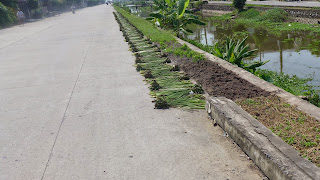 |
When Australians go on holiday it is usually out of the country.
Asia is more affordable and the first stopping point for those
going abroad. So when in AU, do as the Aussies do. The holiday was rather
random in choosing Vietnam and going on a bike tour no less. I had not really considered
the heat, traffic, potholes, or other conditions, but perhaps that was better.
Otherwise, I may not have taken the trip. |
 |
First Stop was Kaula Lumpar, the 28 million populated capital
of Malaysia. I had hardly seen it on the map before as Singapore
gets all of the attention. It was an amazing city, but the best
part was that Cammy, Jingle, Harry, Wilson and the rest of the
extended family were my amazing hosts! Harry (14) took his
job of guide seriously. He was a pro. teaching me everything from
how to properly eat with my hands Indian-style , to instructing me
with the history of his beloved city. |
 |
Without them, I may not have ventured out of lodgings. The vastness of the city
was truly overwhelming. It is a mix of Chinese, Indian, Malay, and Muslim.
So really since we went to all of the districts and ate every
ethnic food, it was if I had travelled to four countries in just under 48
hours. |
 |
| Picnic at the Sri Mahamariamman hindi temple |
 |
| The Temple at Jingle's X-school |
 |
Cammy's birthday celebration at an open-air restaurant
Delicious, and I tried stingray! |
 |
Taoist festival-joss stick dragon
for the nine gods' celebration
Rememberance of the sacrifice
of nine protective fisherman |
 |
| the blue mosque |
Shah Alam is the beautiful city outside KL where Cammy and family live. The Blue Mosque is also located in the town. It has the largest religious domes in the world, and the four minarets are the second tallest.
 |
Cammy and Jingle light incense at the Chinatown's Taoist temple.
The Kuan Ti temple, which was completed in 1888, is dedicated to the
Chinese God of War and Literature. It should be noted that Kuan Ti is
worshipped primarily for his heroic, loyal and righteous character, not for being war-like. |
 |
Rambutan (the red hairy fruit as foreigners call it), my favorite newly introduced fruit-
eaten for cooling |
 |
The Durian (even thouth this is a jack fruit) is known as the king of fruits in SE Asia. I would say
otherwise. It is often banned in elevators and on public
transportation. There is a reason. The edible flesh emits a distinctive
odour that is strong and penetrating even when the husk is intact.
Some people regard the durian as pleasantly fragrant; others find the aroma
overpowering and revolting. The smell evokes reactions
from deep appreciation to intense disgust. I had three sections
before calling it quits. There was much laughter due to my
most animated disgusted expressions! |
What a treat it is to have good friends in a far-off place.Thanks!
. . .
Halong Bay
Name means Descending Dragon Bay
Located in the Quang Ninh province
The limestone in this bay has gone through 500 million years of formation in different conditions and environments. The evolution of the karst has taken 20 million years under the impact of the tropical wet climate. The geo-diversity of the environment in the area has created biodiversity, including a tropical evergreen biosystem, oceanic and sea shore biosystem.
 |
| One of the five students that attends the floating school |
In 2012, the New 7 Wonders Foundation officially named Halong Bay
as one of new seven natural wonders of the world.
 |
| The floating yellow building is the local school. |
 |
Another iconic trip-
Do you remember the James Bond movie Tomorrow
Never Dies? It was filmed here at Halong Bay. |
 |
Many travellers spend days on Halong Bay in luxury boats.
I was glad to have had a day, but many would have been great. |
. . . .
Hanoi
 |
| my traveling companions, stage actors form Denmark and Saigon |
 |
| offerings |
 |
The cyclos are an option if too afraid to tackle the streets
on your own. They most likely arrive quicker than a taxi. The streets
are simply not made for cars and when more locals will own cars
in town there will be a real problem. |
 |
The streets of Hanoi never rest. This is an amazing photo
because everyone is heading in the same direction-a rare
occurrence! I was told to just step off the curve and walk.
Don't stop to look, just keep walking. |
 |
Bikes and scooters outnumber the other modes of transport.
It is as if they carry entire shops. I actually saw a family of four with the mom holding a kitchen
sink all puttering down the road on a scooter. There was a man on a scooter at the midpoint
of a mountain pass hauling hefty bamboo poles of about 8 meters long. One
of my favorite bike sites was of four women with baskets full of ducklings. The babies were
all conversing down the road. Many times pigs and piglets passed by in baskets. |
 |
Someone follows you no matter which direction, trying to sale wares.
The city has many sad sites. |
 |
Not many people wanted me to take their photo
unless children were involved. Then most were
more than willing. |
 |
| The mom put the bow on her little boy to be photographed. |
 |
| This little girl is a natural. |
 |
| and a true beauty |
 |
| The way many country children are carried about |
 |
| This grandma was pleased with the photo op. |
. . . . along the cycling trail
 |
| Drying rice and hay |
 |
Sugar cane is sold on the streets in huge bundles.
Of course large
amounts are seen hanging off bikes and scooters. |
 |
| Peanut harvest-drying on the road |
Harvest time in the country: We first passed rice fields being harvested. When the plant begins to yellow, the water is drained from the fields and the rice is hand-cut and hand-tied in bundles. Then the woman haul it to front yards on the road where it is separated by a communally used thrasher. Next the rice is dried under the sun out on driveways or even in the road. Women walk over it in bare feet or rake it until it is dry. Finally it is taken for milling to remove the outer layer and distributed. Since reunification, it no longer has to be given to the government for distribution.
 |
Passing through spectacular gorges and lakes on "quiet"
back roads |
 |
We visited the thousand year old tree on a hike
to visit the "cave of the Prehistoric Man in Cuc Phuong National Park. |
 |
| The water buffalo tilling the next fields |
 |
Vietnamese cooking school creating local favorites-
Spring rolls, banana flower salad and stuffed tofu |
 |
Most of the terraced fields are around Sapa, but this is
on the climb upThung Khe pass |
 |
| Tapioca root- It's the beginning of harvest time. |
 |
| Cuc Phung Mac Lake |
 |
| Mac Lake |
 |
| Still very few modern methods of farming |
 |
| school outdoors |
 |
an entire street or two was dedicated
to weavers of water hyacinth |
The water hyainth's stems are used as a braiding material and a source of fibers. Strings of dried fibers are woven or interlinked together to form a braid or cord used for making bags, footwear, wreaths, hats and vases. Dried stems are used for baskets and furniture. Water hyacinth fibers are used as a raw material for paper.
 |
Inland Limestone Landscapes
|
.. . . Kenh Gha
 |
| schoolboys in Kenh Gha |
 |
| After school bathing and a swim |
 |
| The main access to village ot Kenh Gha is by boat. |
 |
| New rice fields- Each seedling is transplanted by hand. |
Coming soon: Part 2




























































































